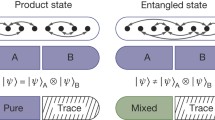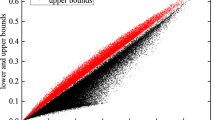Abstract
Quantum entanglement is a unique phenomenon which can be described in quantum mechanics. There are two categories of quantum entanglement: one is based on a single-body system in various freedom degrees and another is found in the multi-body system. In recent years, the spin–orbit coupling effect has been widely concerned. Various electronic devices based on the spin–orbit coupling effect have been emerging in an endless stream and bringing great practical application value. At present, the relationship between single-particle commuting observables \( l_{z} ,s_{z} \) entangled states and the spin–orbit coupling is rarely reported. In this paper, based on the diverse freedom degrees of the quantum entanglement states in a single-body system, the correlation between the sole particle commuting observables \( l_{z} ,s_{z} \) entangled states and the spin–orbit coupling has been analyzed by MATLAB software and the degree of entanglement is measured according to von Neumann entropy. This work provides innovation to further understand quantum entanglement and demonstrates that there is a close relationship between the degree of entanglement and the spin–orbit coupling coefficient \( {j \mathord{\left/ {\vphantom {j 2}} \right. \kern-0pt} 2} - {1 \mathord{\left/ {\vphantom {1 4}} \right. \kern-0pt} 4} \). As \( j \) increases, the degree of the maximum entanglement firstly decreases, then increases, afterward decreases and then increases repeatedly, with the maximum value of entanglement degree being 0.6828. When \( j \) is beyond 85.5, the degree of entanglement will not make sense any longer.








Similar content being viewed by others
References
Einstein, A., Podolsky, B., Rosen, N.: Can quantum-mechanical description of physical reality be considered complete? Phys. Rev. 47(10), 777 (1935)
Schrödinger, E.: Die gegenwärtige Situation in der Quantenmechanik. Naturwissenschaften 23(49), 152 (1935)
Horodecki, R., Horodecki, P., Horodecki, M., Horodecki, K.: Quantum entanglement. Rev. Mod. Phys. 81(2), 865 (2009)
Czachor, M.: Einstein–Podolsky–Rosen–Bohm experiment with relativistic massive particles. Phys. Rev. A 55(1), 72 (1997)
Jordan, T.F., Shaji, A., Sudarshan, E.C.G.: Maps for Lorentz transformations of spin. Phys. Rev. A 73(3), 032104 (2006)
Korbicz, J.K., Lewenstein, M.: Group-theoretical approach to entanglement. Phys. Rev. A 74(2), 022318 (2006)
Rauch, H., Werner, S.A.H.: Neutron Interferometry: Lessons in Experimental Quantum Mechanics, Wave-Particle Duality, and Entanglement, vol. 20. Oxford University Press, Oxford (2015)
Putz, M.V., Ori, O.: Bondonic Chemistry: Physical Origins and Entanglement Prospects Exotic Properties of Carbon Nanomatter, vol. 229. Springer, Dordrecht (2015)
Bal, P.: Physics of life: the dawn of quantum biology. Nat. News 474(7351), 272 (2011)
Lambert, N., Chen, Y.N., Cheng, Y.C., Li, C.M., Chen, G.Y., Nori, F.: Quantum biology. Nat. Phys. 9(1), 10 (2013)
Cai, J.: Quantum biology: explore quantum dynamics in biological systems. Sci. China Inf. Sci. 59(8), 081302 (2016)
Timco, G.A., Carretta, S., Troiani, F., Tuna, F., Pritchard, R.J., Muryn, C.A., Amoretti, G.: Engineering the coupling between molecular spin qubits by coordination chemistry. Nat. Nanotechnol. 4(3), 173 (2009)
Bennett, C.H., Wiesner, S.J.: Communication via one- and two-particle operators on Einstein–Podolsky–Rosen states. Phys. Rev. Lett. 69(20), 2881 (1992)
Bennett, C.H., Brassard, G., Crépeau, C., Jozsa, R., Peres, A., Wootters, W.K.: Teleporting an unknown quantum state via dual classical and Einstein–Podolsky–Rosen channels. Phys. Rev. Lett. 70(13), 1895 (1993)
Bose, S., Vedral, V., Knight, P.L.: Multiparticle generalization of entanglement swapping. Phys. Rev. A 57(2), 822 (1998)
Caban, P., Rembieliński, J.: Lorentz-covariant reduced spin density matrix and Einstein–Podolsky–Rose–Bohm correlations. Phys. Rev. A 72(1), 012103 (2005)
Schuld, M., Sinayskiy, I., Petruccione, F.: An introduction to quantum machine learning. Contemp. Phys. 56(2), 172 (2015)
Brukner, Č., Żukowski, M., Pan, J.W., Zeilinger, A.: Bell’s inequalities and quantum communication complexity. Phys. Rev. Lett. 92, 127901 (2004)
Bovino, F.A., Giardina, M., Svozil, K., Vedral, V.: Spatial orientation by quantum telepathy. Int. J. Quantum Inf. 5, 43 (2007)
Venzl, H., Freyberger, M.: Quantum estimation of a damping constant. Phys. Rev. A 75(4), 042322 (2007)
Giovannetti, V., Lloyd, S., Maccone, L.: Quantum-enhanced measurements: beating the standard quantum limit. Science 306(5700), 1330 (2004)
Jozsa, R., Abrams, D.S., Dowling, J.P., Williams, C.P.: Quantum clock synchronization based on shared prior entanglement. Phys. Rev. Lett. 85(9) (2010)
Raussendorf, R., Briegel, H.J.: A one-way quantum computer. Phys. Rev. Lett. 86(22), 5188 (2001)
Knill, E., Laflamme, R., Milburn, G.J.: A scheme for efficient quantum computation with linear optics. Nature 409(6816), 46 (2001)
Li, Q.T.: Theory and application of quantum entanglement measures. Ph.D. Thesis, Tsinghua University (2017)
Knight, P.: Quantum mechanics: where the weirdness comes from. Nature 395(6675), 12 (1998)
Vedral, V.: Quantifying entanglement in macroscopic systems. Nature 453(7198), 1004 (2008)
Monroe, C., Meekhof, D.M., King, B.E., Wineland, D.J.: A “Schrödinger cat” superposition state of an atom. Science 272(5265), 1131–1136 (1996)
Ruan, M.Q., Zeng, J.Y.: Complete sets of commuting observables of Greenberger–Horne–Zeilinger states. Phys. Rev. A 70(5), 052113 (2004)
Bittencourt, V.A., Bernardini, A.E.: Entanglement of Dirac bi-spinor states driven by Poincaré classes of SU (2) ⊗ SU (2) coupling potentials. Ann. Phys. 364, 182 (2016)
Souza, F.M., Oliveira, P.A., Sanz, L.: Quantum entanglement driven by electron-nanomechanical coupling. arXiv:1804.01123
Slepyan, G., Boag, A., Mordachev, V., Sinkevich, E., Maksimenko, S., Kuzhir, P., Maffucci, A.: Anomalous electromagnetic coupling via entanglement at the nanoscale. New J. Phys. 19(2), 023014 (2017)
Hasan, M.Z., Kane, C.L.: Colloquium: topological insulators. Rev. Mod. Phys. 82(4), 3045 (2010)
Qi, X.L., Zhang, S.C.: The quantum spin Hall effect and topological insulators (2010). arXiv:1001.1602
Qi, X.L., Zhang, S.C.: Topological insulators and superconductors. Rev. Mod. Phys. 83(4), 1057 (2011)
Zhang, N.: The magnetoelectric transport properties and spin dynamics at the oxide interfaces. Ph.D. Thesis, Lanzhou University (2017)
Cui, J.X.: Quantum effect in ultracold spin–orbit coupled atomic fermi gases and applications. Ph.D. Thesis, Tsinghua University (2013)
Zeng, J.Y.: Quantum Mechanics Tutorial, vol. 150. Science Press, Berlin (2014)
Wang, R.: Reseaches on quantum nonlocality and contextuality by weak microwave signal detection. Ph.D. Thesis, Southwest Jiaotong University (2017)
Nakagawa, K.: Entanglement entropies of coupled harmonic oscillators. arXiv:1601.03584
Paškauskas, R., You, L.: Quantum correlations in two-boson wave functions. Phys. Rev. A 64(4), 042310 (2001)
Xiang, L., De-Wei, W., Xi, W., Qiang, M., Kun, C., Chun-Yan, Y.: A method of evaluating the quality of dual-path entangled quantum microwave signal generated based on von Neumann entropy. Acta Phys. Sin. 65(11) (2016)
Wootters, W.K.: Entanglement of formation of an arbitrary state of two qubits. Phys. Rev. Lett. 80(10), 2245 (1998)
Bennett, C.H., DiVincenzo, D.P., Smolin, J.A., Wootters, W.K.: Mixed-state entanglement and quantum error correction. Phys. Rev. A 54(5), 3824 (1996)
Vedral, V., Plenio, M.B.: Entanglement measures and purification procedures. Phys. Rev. A 57(3), 1619 (1998)
Vidal, G., Werner, R.F.: Computable measure of entanglement. Phys. Rev. A 65(3), 032314 (2002)
Cheng, P.X.: Study on purification of entanglement and local distinguishability of orthogonal quantum states. Ph.D. Thesis. 14, National University of Defense Technology (2003)
Bernardini, A.E., Mizrahi, S.S.: Relativistic dynamics compels a thermalized fermi gas to a unique intrinsic parity eigenstate. Phys. Scr. 89(7), 075105 (2014)
Sadiek, G., AlDrees, W., Abdallah, M.S.: Manipulation of two quantum systems through their mutual interaction in presence of a radiation field. arXiv:1802.01935
Sun, S.H.: Basic concept of von Neumann entropy. Educ. Teach. Forum 43, 279 (2016)
Feng, C.: Study about five-fold-degenerate point of spin-2. Ph.D. Thesis. 1, Nanjing University (2019)
Acknowledgements
The authors would like to thank the library of Nanjing University of Aeronautics and Astronautics (NUAA) offering sufficient materials for us to study this paper.
Author information
Authors and Affiliations
Corresponding author
Additional information
Publisher's Note
Springer Nature remains neutral with regard to jurisdictional claims in published maps and institutional affiliations.
Rights and permissions
About this article
Cite this article
Tang, JM., Zeng, QS., Luo, YB. et al. The relationship between single-particle commuting observables lz, sz entangled states and the spin–orbit coupling. Quantum Inf Process 19, 40 (2020). https://doi.org/10.1007/s11128-019-2537-6
Received:
Accepted:
Published:
DOI: https://doi.org/10.1007/s11128-019-2537-6




